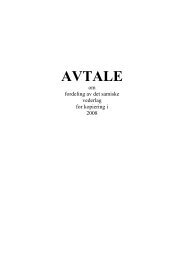Samisk mytologi og folkemedisin
Samisk mytologi og folkemedisin
Samisk mytologi og folkemedisin
You also want an ePaper? Increase the reach of your titles
YUMPU automatically turns print PDFs into web optimized ePapers that Google loves.
Jagi 1609 Várggáid ladni hoavda oaččui dieđu gonagas<br />
Christian IV:s ahte buohkat geat gávnnahalle<br />
noaidevuođa bálvaleamen, galge dubmejuvvot<br />
jápmimii. Govva čájeha Christian IV 1599:s, dan jagi<br />
go son dagai mátkki gitta davvi ja nuorta Sápmái,<br />
bealuštit Dánmárkku ja Norgga vuoigatvuođaid<br />
dáppe.<br />
I 1609 fikk kommandanten på Vardøhus festning<br />
bud fra kong Christian IV om at alle som ble tatt i å<br />
utøve trolldomskunster, i hekseri som det <strong>og</strong>så ble<br />
kalt, måtte bøte med livet. Om det ryktes at samene<br />
bedrev sine noaidikunster, så måtte de jages bort fra<br />
Sápmi. Kongens befaling om noaidiene skulle få en<br />
slutt på samenes egen religion – noaidevuohta.<br />
In 1609, the Commander at Vardøhus Fortress<br />
received an order from King Christian IV commanding<br />
that everyone who was caught in the act of<br />
practicing sorceries, or witchcraft which it was<br />
also called, had to pay with their life. If there were<br />
rumours that the Samis were practicing their noaidi<br />
skills, they had to be driven away from Sápmi. The<br />
King’s order against the noaidi was supposed to put<br />
an end to the Samis’ own religion – noaidevuohta.<br />
Dát ruoŧa sárggus 1670:s čájeha noidošanmeanuid.<br />
Ovddabealde noaideáhkut ja noaiddit. Gasku gurutbealde<br />
noaiddit mat leat váldon gitta; daid ovddabealde<br />
dutkkadankommišuvdna mii guldala nissoniid<br />
ja mánáid váidalusaid. Du<strong>og</strong>ábealde noaidedolla.<br />
Dette svenske kobberstikket fra 1670 viser en<br />
trolldomsprosess i dens ulike faser. I forgrunnen<br />
hekser <strong>og</strong> trollmenn. I midten til venstre drives en<br />
flokk fangne hekser <strong>og</strong> trollmenn fram. Foran dem<br />
hører en forhørskommisjon på anklager fra kvinner<br />
<strong>og</strong> barn. I bakgrunnen heksebålet omgitt av djevler,<br />
hekser som bortfører barn, flyvende hekser <strong>og</strong><br />
demoner.<br />
This Swedish copper engraving from 1670 shows<br />
a sorcery process in its different stages. In the<br />
foreground, witches and sorcerers. In the centre on<br />
the left, a group of captured witches and wizards are<br />
pushed forward. In front of them, an interr<strong>og</strong>ation<br />
committee listens to accusations from women and<br />
children. In the background, the witches’ bonfire<br />
surrounded by demons, witches who are abducting<br />
children, flying witches and demons.<br />
name, called sámenamma – “Same-Nabma”<br />
or sáivonamma – “Saiwo-Nabma”. They believed<br />
that the Christian baptism and the<br />
Norwegian name could make the child sick,<br />
and hamper his/her development.<br />
Diseases and cures<br />
The drum as a Bible and medicine<br />
When they (the noaidi) want to cure<br />
diseases and bad health with the drum,<br />
they do it in the following way: The<br />
sick person must give the person who<br />
owns the drum a brass and a silver ring,<br />
which he/she ties around the drummer’s<br />
right arm as payment for his troubles.<br />
Later, the drummer ties the rings in his<br />
bunch of rings, which is always used<br />
when he beats on the drum. While he<br />
beats on the drum, all the men and<br />
women who are present have to sing.<br />
The men sing with a loud voice, and<br />
the women with a softer voice. Then<br />
the drummer discovers whether the<br />
disease is of natural causes or a result<br />
of someone casting the disease on the<br />
sick person (Samuel Rheen, 1671.<br />
According to Brita Pollan, 2002).<br />
This is how the Swedish-Sami priest Samuel<br />
Rheen describes how the noaidi used the<br />
drum to interpret and cure diseases.<br />
In Sami folk medicine, the drum –<br />
goavddis, gievrie, kyömdes – held a central<br />
position. With the drum, the noaidi could<br />
read both the cause of the individual disease<br />
and how it should be cured. The drum<br />
functioned as both Bible and medicine, and<br />
the noaidi was both priest and doctor<br />
When the noaidi beat on the drum,<br />
“the pointer” – vuorbi, árpa – wandered<br />
amongst the figures and gave the noaidi<br />
advice and answers. If the vuorbi moved<br />
in the direction of the sun or towards the<br />
41




